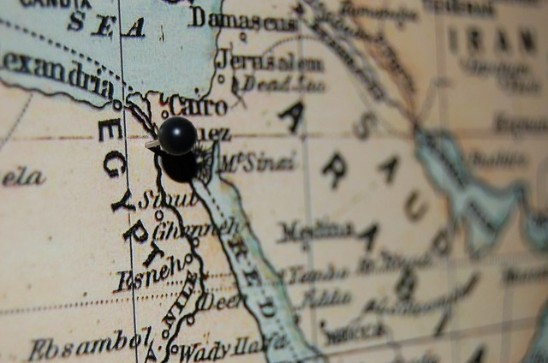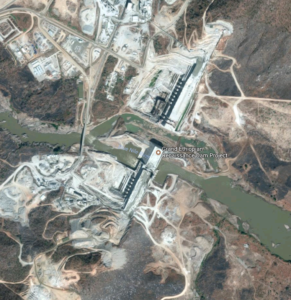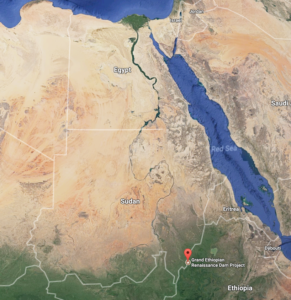
The Grand Ethiopian Renaissance Dam: Power Dynamics in the Nile River Basin
Once completed, the Grand Ethiopian Renaissance Dam (GERD) will be the largest dam in Africa. Located about 20 miles from the Sudan border, GERD is projected to produce 6,000 megawatts of electricity for both domestic use and for exportation. To compare, Ethiopia currently has the capacity to produce only 3,200 megawatts. Ethiopia’s per capita consumption of electricity is among the lowest in the world, using just 65 kilowatt hours while the world average is 3,104 kilowatts hours. Without access to electricity, many Ethiopians rely on alternative sources of energy, such as wood, dung, and other forms of biomass. The World Bank estimates that Ethiopia could earn $1 billion a year from electricity exports, which would make it the largest exporter of power in Africa.
 The Ethiopian government has touted the Grand Renaissance Dam as an incredibly important project for the country, calling it a “strategically important initiative” and has refused any international money for the dam as a point of national pride. The estimated $5 billion project is being funded partly through bond offerings to Ethiopian citizens, but mainly through tax collection and citizen wage “donations.”
The Ethiopian government has touted the Grand Renaissance Dam as an incredibly important project for the country, calling it a “strategically important initiative” and has refused any international money for the dam as a point of national pride. The estimated $5 billion project is being funded partly through bond offerings to Ethiopian citizens, but mainly through tax collection and citizen wage “donations.”
Dams, like all other development projects, face multifaceted criticism – GERD is no different. Environmental groups have cited that the dam will flood 1,680 square kilometers of forest and will displace approximately 20,000 people. A credible environmental impact assessment has not been conducted, so the extent of environmental impact is unknown.
The most serious consequence of the announcement and construction of GERD has been international tension between the states of the Nile River Basin, specifically between Ethiopia and Egypt. The Nile River is the longest river in the world and is formed by the convergence of the White Nile and the Blue Nile, which join in Sudan. Egypt is worried about GERD because of their huge dependence on the Nile River, which supplies 90% of their water. Of that, around 60% originates in Ethiopia. One study showed that due to the decreased flow of water, Egypt could lose 51% of its farmland if the dam reservoir were filled in three years, while a six-year fill could result in a 17% loss, substantially impacting the agricultural sector. However, the exact impact of the dam is highly contested, especially given that the consultants hired to produce impact studies have not released their full technical report yet.

In addition to the already complex situation, the history of the Nile’s water use is highly disproportionate. Egypt has two agreements, one from 1929 and the other from 1959, that guarantees the country over two-thirds of the water the river contains per year. These agreements were created when many of the lower Nile basin countries were under colonial rule, and consequently were not party to nor consulted on these agreements.
Both Egypt and Ethiopia consider the dam to be a national security issue, and in 2013, then Egyptian president Mohamed Morsi publicly stated that “all options” were on the table if construction of the dam continued, including military action. Some worried that Egypt would bomb the dam, or that the two countries would become involved in a war. However, Egypt, Sudan – who was also a party to the colonial era agreements – and Ethiopia were able to agree to a Declaration of Principles document in 2015. The agreement included 10 points, including a principle of not causing significant harm to any other basin state and a principle of fair and appropriate use of Nile waters.
By signing the agreement, the three countries indicated that they wished to cooperate. As Ethiopia beings to fill the reservoir and completion of the dam nears, the ability of Egypt, Ethiopia, and Sudan to work together will be put to the test. Given that the effects of the dam are mostly unknown, especially with the effects of climate change impacting water in a myriad of ways, future conflict is not out of the question. Egypt has been experiencing internal instability since the Arab Spring, and reduced water flow that seriously impacts agriculture could provide a catalyst for more protests. Though the agreement signaled a cooperative spirit, the Egyptian foreign minister recently spoke of “difficult talks” and complained about the delay in the impact assessment. However, another official acknowledged that there is little Egypt can do now, with the dam being so near to completion. The key will be to continue to use the Declaration of Principles and other institutional frameworks to foster transboundary cooperation and prevent conflict. Yet, Egypt’s position as the dominant power in the Nile River Basin is not as firm as it once was, and with the construction of the Grand Ethiopian Renaissance Dam, Ethiopia is asserting itself as a rising regional power.






